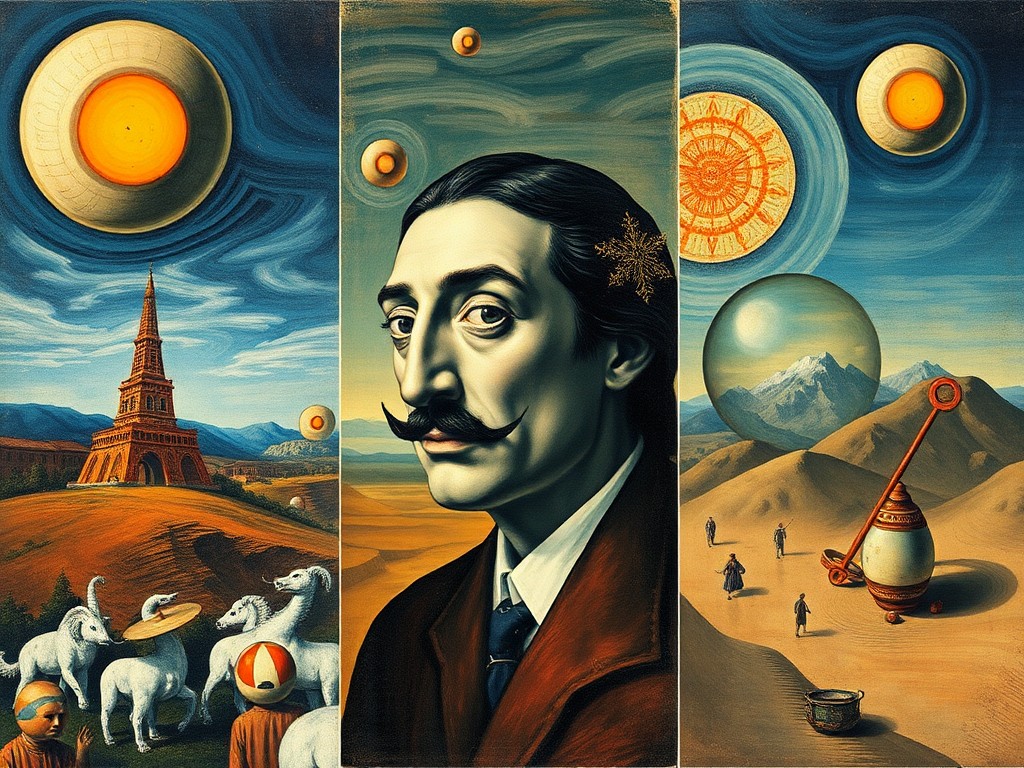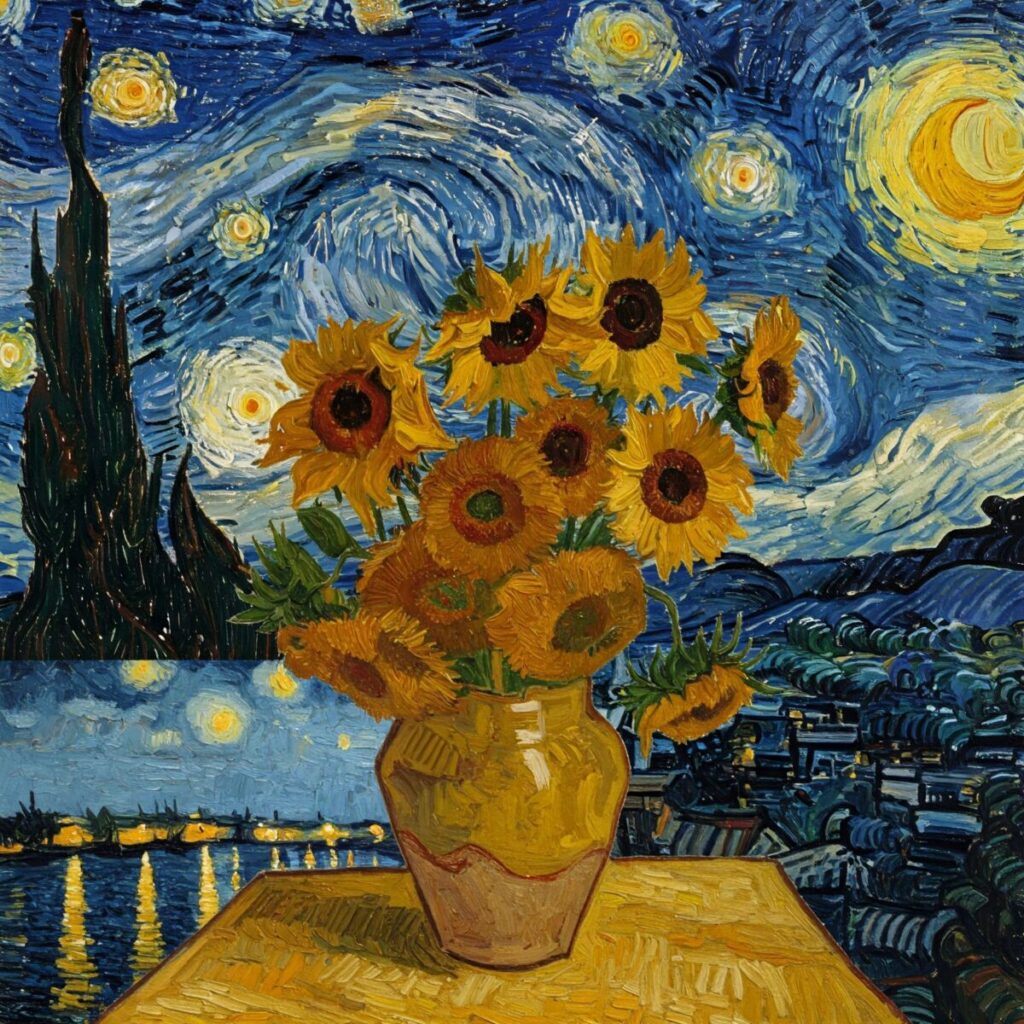Step into a world of shimmering light, rosy cheeks, and joyful moments! Pierre-Auguste Renoir was a master painter who helped start one of the most famous art movements ever: Impressionism. Unlike some artists who focused on serious subjects, Renoir wanted his art to be a source of happiness and beauty. The most famous Renoir paintings are like snapshots of a perfect sunny afternoon, capturing the feeling of a moment rather than just the details. He used his brush like a magic wand, turning simple scenes of people dancing, boating, or just relaxing into timeless masterpieces. Let’s explore the top 10 Renoir paintings that continue to enchant audiences around the world.
Bal du Moulin de la Galette (1876)

Description: Imagine stepping into a lively outdoor party in 19th-century Paris. This painting is a huge, bustling scene filled with Renoir’s friends chatting, dancing, and laughing under the dappled sunlight filtering through the trees. It’s a masterpiece of movement and light, making you feel like you can almost hear the music and conversation. Many of the people featured in this vibrant scene were actually Renoir’s personal friends, including fellow artists and writers.
Painting Techniques: Renoir used quick, feathery brushstrokes to capture the fleeting effects of sunlight. He applied vibrant colors directly to the canvas, creating a shimmering, energetic surface that perfectly conveys the lively atmosphere of the dance hall.
Location: Musée d’Orsay, Paris, France
Estimated Value: Priceless
Luncheon of the Boating Party (1881)

Description: This iconic painting shows a group of Renoir’s friends relaxing on a balcony overlooking the Seine River after a lovely lunch. Each person has a unique personality, from the woman playing with her dog to the man in the straw hat looking on. It perfectly captures a moment of leisure and friendship. The woman holding the dog in the bottom left is Aline Charigot, who would later become Renoir’s wife.
Painting Techniques: Renoir masterfully combined figure painting with a still life of the leftover lunch and a landscape in the background. His use of rich colors and soft light unifies the complex composition, making the scene feel warm and inviting.
Location: The Phillips Collection, Washington, D.C., USA
Estimated Value: Priceless
The Large Bathers (1887)
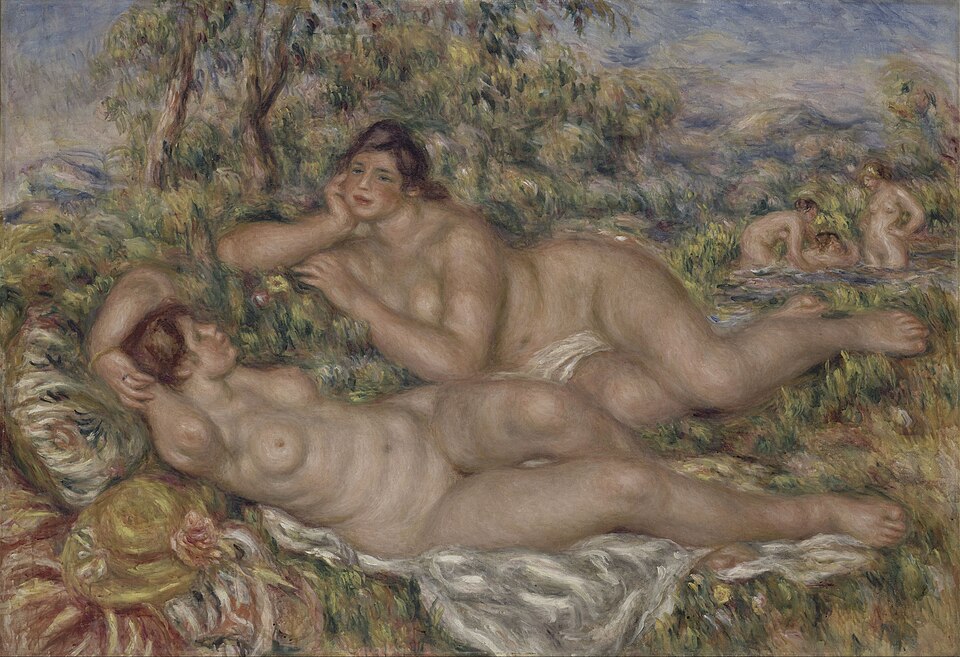
Description: This painting marks a shift in Renoir’s style. Here, a group of nude women lounge by the water in a timeless, classical setting. The figures are smooth and sculpted, almost like statues, which is very different from his earlier, more blurry Impressionist work. It shows Renoir experimenting with a more disciplined and linear approach. Renoir spent about three years working on this painting, creating numerous preparatory drawings to perfect the composition.
Painting Techniques: Renoir moved away from typical Impressionism here, using crisp, clear outlines for the figures, inspired by classical art. The background remains soft and painterly, creating a striking contrast between the sharply defined women and the hazy landscape.
Location: Philadelphia Museum of Art, Philadelphia, USA
Estimated Value: Priceless
Dance at Bougival (1883)

Description: Feel the romance and energy of the dance floor! This full-length portrait shows a couple lost in a swirling waltz. The man’s face is in shadow, but the woman’s face is lit up with a joyful expression. You can almost feel the movement and the connection between the two dancers. The female dancer is believed to be Suzanne Valadon, who was an artist’s model before becoming a successful painter herself.
Painting Techniques: Renoir used fluid, energetic brushwork to convey the motion of the dance. The woman’s dress is a cascade of light and color, while the background is painted more loosely, ensuring the focus remains squarely on the happy couple.
Location: Museum of Fine Arts, Boston, USA
Estimated Value: Priceless
Girls at the Piano (1892)
Description: This is one of Renoir’s most charming paintings, showing two young girls in a cozy, middle-class home focused on their piano music. The scene is intimate and sweet, capturing a quiet moment of concentration and shared interest. The warm colors make the room feel comfortable and safe. The French government purchased this painting in 1892, which was a major sign of official recognition for Renoir’s work.
Painting Techniques: This work exemplifies Renoir’s ‘Pearly’ period, characterized by soft, luminous colors and gracefully flowing brushstrokes. He delicately renders the girls’ hair and dresses, giving the entire scene a soft, almost glowing quality.
Location: Musée d’Orsay, Paris, France
Estimated Value: Priceless

Two Sisters (On the Terrace) (1881)

Description: A beautiful portrait of two girls on a terrace overlooking a river. The older girl gazes directly at the viewer, while the younger one looks off into the distance. Renoir fills the canvas with vibrant colors, especially in the flowers and the girls’ hats, creating a scene that feels like the perfect spring day. Despite the title, the two girls in the painting were not actually sisters but unrelated models.
Painting Techniques: Renoir combines a detailed, carefully painted portrait of the two girls with a looser, more Impressionistic background. This contrast makes the figures pop, and his use of brilliant reds and blues makes the canvas sing with color.
Location: Art Institute of Chicago, Chicago, USA
Estimated Value: Priceless
La Grenouillère (1869)
Description: This painting is like the birthplace of Impressionism. Renoir and his friend Claude Monet set up their easels side-by-side to paint this popular boating resort near Paris. Renoir focuses on the people and the joyful atmosphere, using quick dabs of paint to capture the reflections of light on the rippling water. Monet painted the exact same scene at the same time, and comparing his version with Renoir’s shows their different artistic priorities.
Painting Techniques: This piece is a classic example of early Impressionism, featuring short, thick brushstrokes and a focus on capturing the sensory effect of a scene. Renoir used broken color to depict the shimmering water, a revolutionary technique at the time.
Location: Nationalmuseum, Stockholm, Sweden
Estimated Value: Priceless
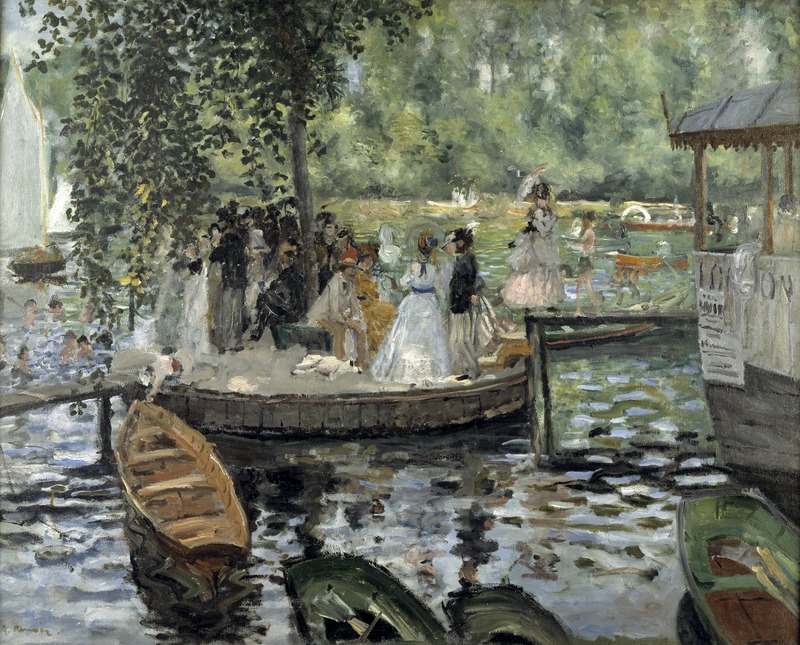
The Umbrellas (c. 1881–1886)
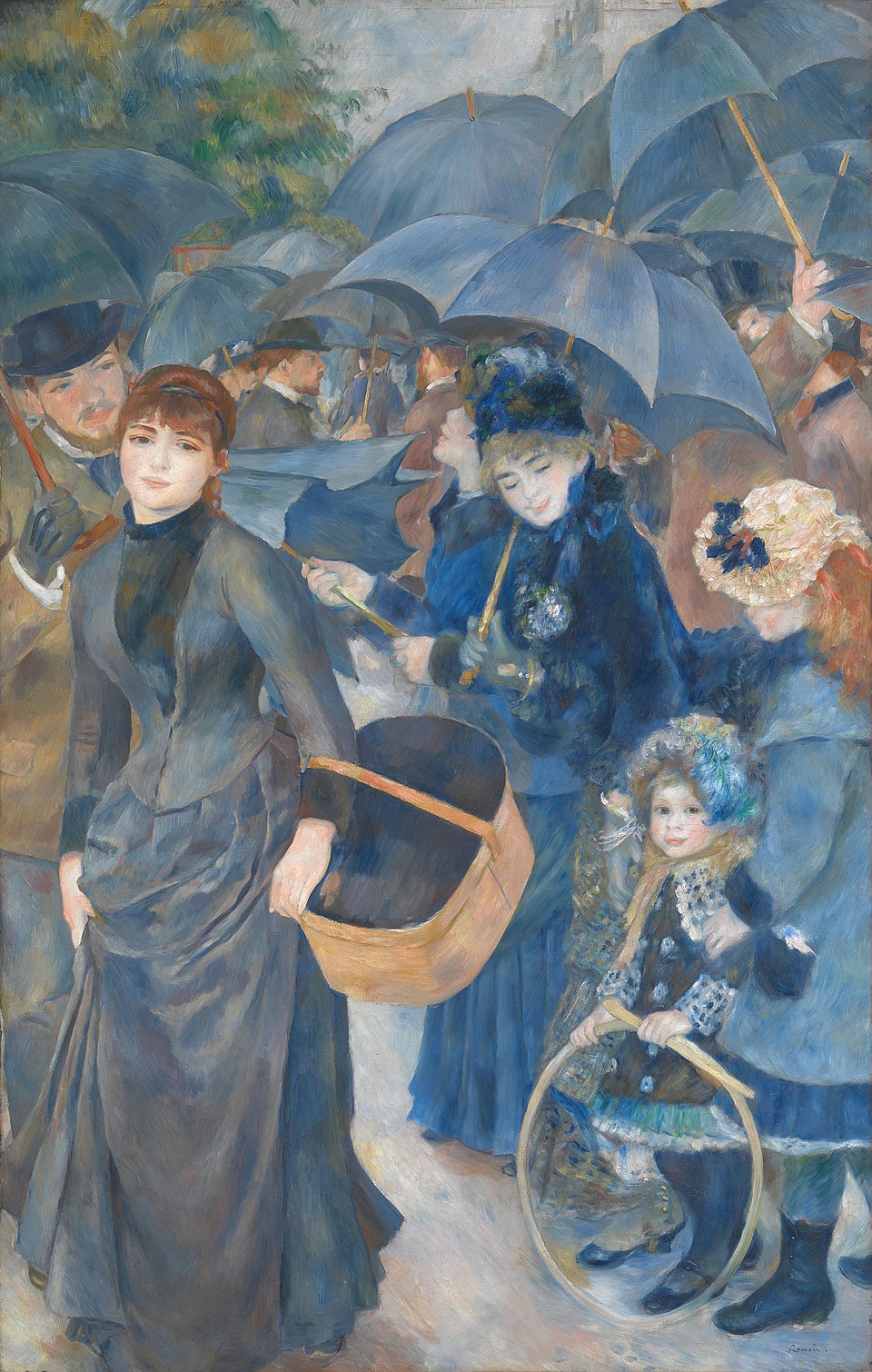
Description: This fascinating painting shows a crowd of Parisians caught in a sudden rain shower. What makes it so unique is that Renoir painted it in two different stages, years apart. The people on the right are painted in his soft, feathery Impressionist style, while the woman and girls on the left are drawn with the sharp, clear lines of his later period. X-ray analysis has revealed the significant changes Renoir made to the composition over the five years he worked on it.
Painting Techniques: This painting is a tale of two styles: the right side, painted around 1881, is soft and Impressionistic, while the left side, finished around 1886, is more linear and classical. This provides a unique look into Renoir’s artistic evolution all on one canvas.
Location: The National Gallery, London, UK
Estimated Value: Priceless
A Girl with a Watering Can (1876)
Description: This is pure sweetness on a canvas. A little girl in a beautiful blue dress stands in a lush garden, holding a small watering can. Her innocent expression and the vibrant, sun-drenched garden behind her make this one of Renoir’s most beloved portraits of children. The garden setting is likely the one at Renoir’s own home in Montmartre, Paris.
Location: National Gallery of Art, Washington, D.C., USA

Painting Techniques: Renoir used delicate brushwork to capture the texture of the girl’s lace-trimmed dress and the lushness of the garden. The bright, high-key colors and the way the light hits her face and the path are hallmarks of his Impressionist peak.
Estimated Value: Priceless
Madame Georges Charpentier and Her Children (1878)

Description: This large portrait shows the wife of a wealthy publisher in her elegant Parisian apartment with her two young children and the family dog. It’s a relaxed, informal scene that was very different from the stiff, formal portraits of the time. The painting was a huge success and helped establish Renoir’s reputation as a leading portrait painter. Interestingly, her son Paul is dressed in an identical lace dress as his sister Georgette, which was common for young boys at the time.
Painting Techniques: Renoir expertly captured the luxurious textures of the room, from the Japanese screen to the silk dresses and plush carpet. He used a fluid painting style to create a scene that feels natural and unposed, full of warmth and familial affection.
Location: The Metropolitan Museum of Art, New York City, USA
Estimated Value: Priceless
Inspiration and Legacy
Renoir was deeply inspired by the elegance and light-heartedness of earlier French Rococo painters like Jean-Honoré Fragonard and François Boucher, whose work he studied at the Louvre. He combined their love for charming subjects with the modern techniques he developed alongside his fellow Impressionist, Claude Monet, with whom he often painted. Renoir’s own legacy is immense. His revolutionary use of color and his focus on depicting beauty in everyday life had a profound impact on future generations of artists. Masters like Henri Matisse and Pablo Picasso both admired Renoir’s work, with Picasso famously once saying, ‘Renoir is a painter who has never been a bore.’
Final Thoughts
Pierre-Auguste Renoir gave the world a timeless gift: a vision of life at its most beautiful. He believed that paintings should be ‘likable, joyous, and pretty,’ and his work certainly lives up to that ideal. From bustling dance halls to quiet family moments, the best Renoir paintings remind us to find the joy and light in the world around us. His ability to capture fleeting moments with warmth and vibrant color ensures that his art remains as beloved today as it was over a century ago, cementing his status as a true master of Impressionism.
FAQs: Top 10 Renoir paintings
What is Impressionism?
Impressionism was an art movement in the 19th century where artists tried to capture the ‘impression’ of a moment, not a perfect, detailed picture. They were famous for using visible brushstrokes, focusing on light and color, and painting everyday scenes outdoors.
Why did Renoir’s painting style change?
After a trip to Italy in 1881, Renoir was inspired by classical Renaissance art. He began to feel that Impressionism lacked form and structure, so he started using more defined outlines and smoother surfaces in what is known as his ‘Ingres’ or ‘Pearly’ period, as seen in ‘The Large Bathers’.
How did Renoir paint when he got older?
Later in life, Renoir suffered from severe arthritis, which made it very difficult to hold a brush. Amazingly, he didn’t stop painting. He would have a brush strapped to his crippled hands so he could continue to create his beautiful, colorful artworks.
Where can I see the most Renoir paintings?
While his works are in museums all over the world, the Musée d’Orsay in Paris, France, and the Barnes Foundation in Philadelphia, USA, hold two of the largest and most important collections of Renoir’s paintings.


